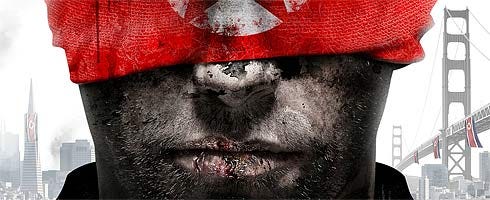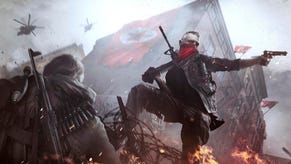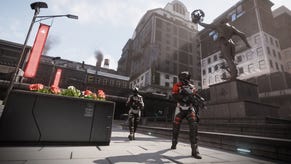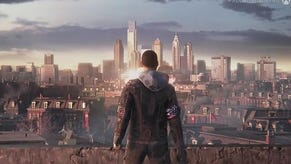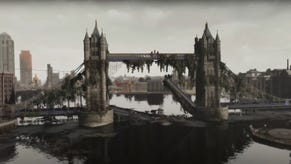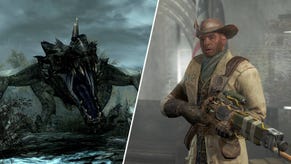Hands-on: Homefront's an innovative FPS which doesn't shy away from controversial themes
Modern military FPS games, viewed ungenerously, are basically a sequence of orders cloaked in comfortingly abstract jargon, removing any illusion that you're shooting at actual people. Go here, put C4 on that, shoot that dude, defend this building, oskar mike tango down eliminate contact GET ON THE MACHINEGUN RAMIREZ . As a cog in the war machine, you barely even know whether you're fighting for the good guys. Who cares, anyway, so long as there are objective markers?
Homefront is a bit different. In its opening sequence, you are handcuffed to a schoolbus and forced to watch an invading Korean army round people up in front of houses and shoot them in front of their small, screaming children, splattering the insides of their heads against the window. Well, there's your motivation.
Let's recap: why is this happening? Homefront is set in a hypothetical version of the year 2027, in which a reunited, nuclear-armed Korea invades and successfully occupies the USA. You – a voiceless and as-yet nameless protagonist – are assaulted in your shabby apartment and captured by the Korean Army. The game's opening has you marched onto a classic suburban-American yellow schoolbus in a row of other hostages, poked in the back with assault rifles. Around you, men and women are being bullied at gunpoint by Koreans screaming in badly-accented English.
Homefront's opening is an inverted image of typical, relatively affluent, small-town America. It's got picket-fences, rows of characterless houses set out in grids, concrete high-schools and SUVs nestled in parking spaces, but everything has been ruined by war. It's designed to awaken a profound sense of unease in anyone brought up in those surroundings, and it does so cleverly, taking universal American symbols like the flag and the schoolbus and turning them sinister and decayed.
On the schoolbus, you're essentially forced to watch the brutality of the Korean invading force from the window, though you can turn the camera away if it's all too much. People are lined up against walls and shot, or thrown to the ground and kicked until they're limp. Couples and families are dragged screaming away from each other. A mother screams at her toddler to look away before she's shot in front of him. Blood-spatter spurts against the window.
If this all sounds unnecessarily gratuitous, it really is. The imagery here is uncomfortably reminiscent of grainy black-and-white footage of civilians rounded up and shot in Nazi death camps or town massacres, except in a modern context and setting that's immediately recognisable to anybody who's even seen an American film. Why this brutality? What justifies the Korean army's behaviour during this invasion? Homefront will need firm justification for this to avoid seeming needlessly tasteless, but despite the gratuitousness, it's not completely implausible. It's not like things like this haven't happened in real life. It just hasn't happened on American soil, yet.
The point of all this is to hammer home one of Homefront's main ideas: violence has consequences, and the people in this game are humans, not targets. Back on the schoolbus, the captive in front of you whispers conspiratorially, speculating on whether you're being taken to a forced labour camp. All of a sudden an explosion tears up the road ahead and the bus rolls on its side, killing your would-be comrade. Two resistance fighters pull you out of the bus, tell you to pick up a gun, and from then on, things feel more familiar. The three of you shoot your way to a resistance hideout, running through and between houses, on the run from Korean soldiers spilling from tanks the main streets.
Running through this setting with a gun feels very strange. We've played games in post-apocalyptic America before, of course, but not a ruined version of modern America. At one point, we're using pieces of a plane that's fallen out of the sky as cover, shooting over banks of seating whilst enemies climb over a snapped-off wing and snipe from second-floor windows of smashed-up houses. Later, the opposition throws canisters of tear gas into a civilian home whilst we're hiding inside.
Everything's very scripted, of course. Enemies pop up from predetermined places and stay behind their particular little scraps of cover until you've moved to the right place to trigger the next event. Stray from your companions, and you'll usually be foiled by a closed door until they catch up. Decide to rush the tank instead of use the helpfully signposted route to flank it, and you're done for. (Admittedly this is probably what would happen in real life, too.)
Our two companions are constantly talking, shouting advice or speculating on the movements of the Korean army. The one we meet in the first fifteen minutes isn't particularly pleasant – he's an aggressive ex-military type, and a bit racist, and keeps getting into violent disagreements with other members of the resistance. Kaos has been keen to emphasise that the Korean army aren't the only bad guys in this story, and that the civilian resistance isn't a team of saintly superheroes.
The first-person viewpoint, lack of obvious expository information and refusal to leave the action even for a second are reminiscent of Half-Life 2, a game that Kaos Studios calls its “main inspiration”. If it's shooting for Half-Life 2's immersion, though, it's currently a long way from its subtlety. There's time to tidy up the scripting and the flow of the action so that you're not standing in front of a door for ten seconds before the appropriate NPC opens it for you, but things like clear objective markers and flashing packages of C4 to throw at tanks rather ruin the illusion.
It's bold, though, and admirably uninterested in the super-soldier, action-movie mentality of COD and MOH. The opening certainly has impact, even if it does veer uncomfortably towards shock tactics on first impressions; over the course of a whole single-player campaign, though, there's room for the story to stretch its legs and develop the context for this war. The setting is certainly provocative – Homefront will probably make American audiences distinctly uncomfortable. There's the potential for greatness here, for an FPS that actually innovates with its content rather than shying away from controversial themes.
Homefront is out March 8 in the US and March 11 in Europe and the UK.
